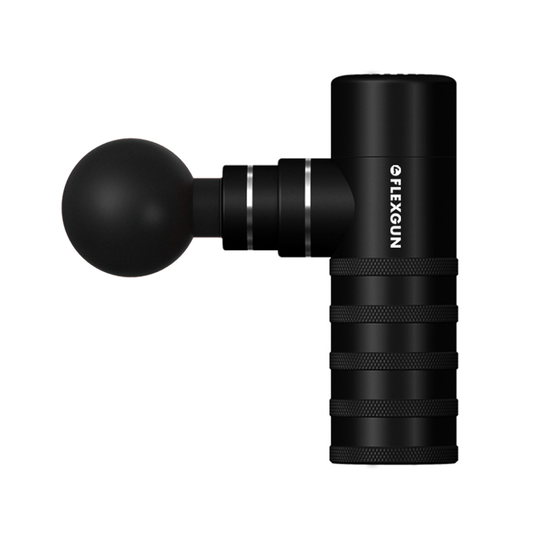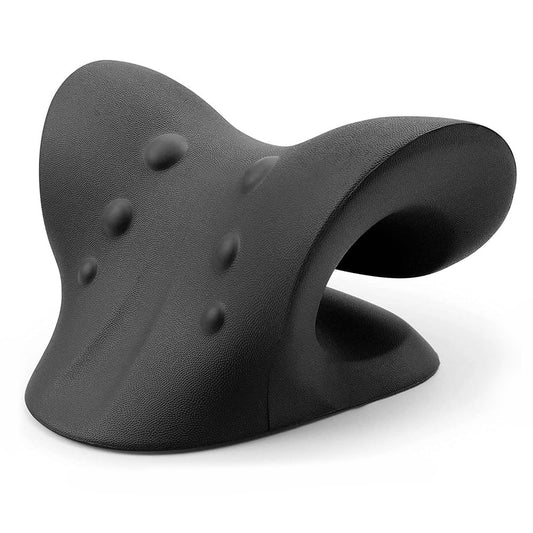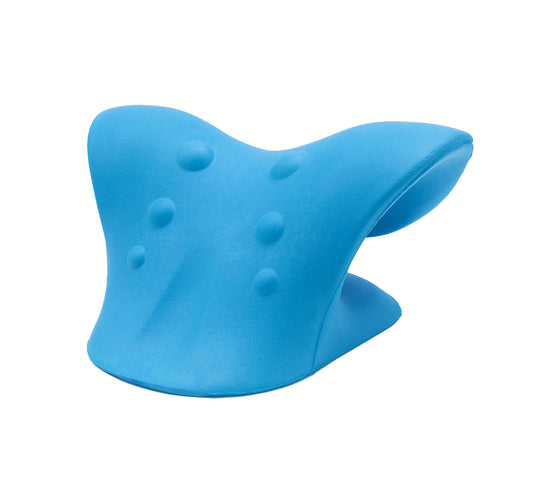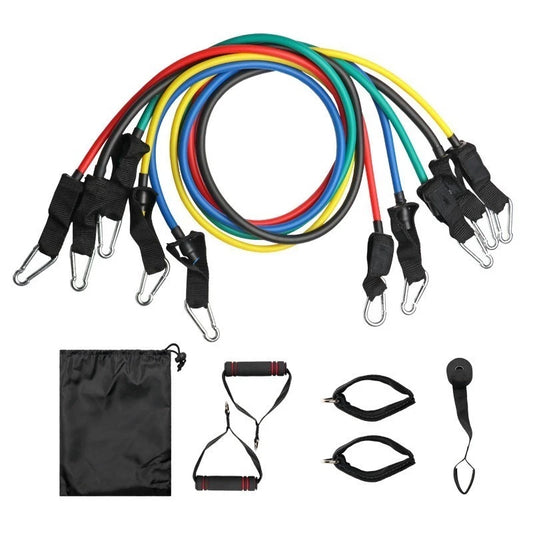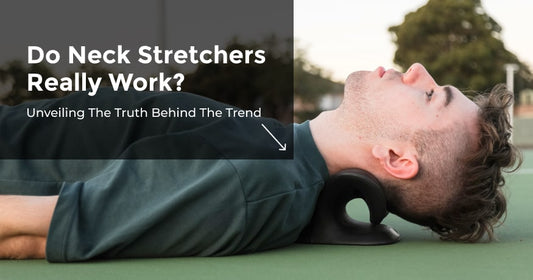Poor posture is a common cause of neck pain and discomfort. With many people spending long hours sitting at desks or using electronic devices, it's no surprise that posture-related issues are on the rise.
In this blog article, we'll provide you with a comprehensive posture analysis checklist to help you assess your posture and identify areas for improvement. We'll also answer some common questions about fixing neck pain caused by bad posture and how the Flex Neck and Shoulder Stretcher device could be a solution for you.
The Connection Between Posture and Neck Pain
Poor posture is a significant contributor to neck pain and discomfort. When the body is not properly aligned, it places excessive strain on the muscles, ligaments, and joints, particularly in the neck and upper back. This strain can lead to muscle imbalances, decreased mobility, and chronic pain. Understanding the connection between posture and neck pain is essential for identifying potential causes of discomfort and implementing effective solutions.
Muscle Strain and Imbalances
When your posture is poor, the muscles in your neck and shoulders have to work harder to support the weight of your head. This constant strain can cause the muscles to become tight, weak, or imbalanced, leading to pain and stiffness. For example, forward head posture (commonly known as "text neck") forces the muscles at the back of the neck to remain contracted to counterbalance the weight of the head, resulting in tension and discomfort.
Spinal Misalignment
Poor posture can also cause misalignment in the spine, which may contribute to neck pain. The cervical spine (the uppermost part of the spinal column) has a natural curve that helps distribute the weight of the head evenly. However, when the head is consistently held in a forward position, this curve can become exaggerated or flattened, placing additional stress on the vertebrae, discs, and surrounding tissues.
Nerve Compression
In some cases, poor posture can lead to nerve compression in the neck, causing pain, numbness, or tingling sensations that may radiate down the arms. For instance, hunching the shoulders and rounding the upper back can compress the nerves that run through the neck and shoulder area, leading to a condition called thoracic outlet syndrome.
Joint Degeneration
Over time, poor posture can contribute to the degeneration of the joints in the neck and upper back. The increased pressure on the cervical spine caused by improper alignment can accelerate the wear and tear on the intervertebral discs and facet joints, potentially leading to conditions such as osteoarthritis or degenerative disc disease.

Posture Analysis Checklist
Use the following checklist to evaluate your posture and determine if it may be contributing to your neck pain:
-
Head Position
- ☑️ Is your head centered over your shoulders, or does it tilt forward?
-
☑️ Is your chin parallel to the floor, or do you often look down?
-
Shoulder Alignment
- ☑️ Are your shoulders level and relaxed, or are they hunched up towards your ears?
-
☑️ Do your shoulder blades lie flat against your back, or do they protrude outward?
-
Upper Back and Spine
- ☑️ Is your upper back straight, or is there a noticeable curve (hunchback)?
-
☑️ Does your spine maintain its natural S-curve, or is it overly arched or flattened?
-
Lower Back and Pelvis
- ☑️ Is your lower back slightly curved inward, or is it excessively arched or flat?
-
☑️ Is your pelvis neutral, or does it tilt forward or backward?
-
Arm and Wrist Position
- ☑️ When standing, do your arms hang naturally at your sides, or do they cross in front of your body?
-
☑️ When typing or using a computer, are your wrists straight and relaxed, or are they bent upward or downward?
-
Legs and Feet
- ☑️ Are your knees directly above your ankles, or do they bow inward or outward?
-
☑️ Are your feet pointed straight ahead, or do they turn inward or outward?
-
Seated Posture
- ☑️ When sitting, do you maintain an upright position with your feet flat on the floor, or do you slouch or cross your legs?
-
☑️ Do you use lumbar support to maintain the natural curve of your lower back, or do you sit without proper support?
Causes of Poor Posture
There are several factors that contribute to poor posture, including:
- Prolonged sitting or standing in awkward positions
- Weak muscles, particularly in the neck, shoulders, and upper back
- Obesity or carrying excess weight
- Stress and tension
- Injuries or medical conditions affecting the spine
One specific cause of neck pain and poor posture is Forward Head Posture (FHP). FHP occurs when the head shifts forward relative to the shoulders, placing strain on the neck muscles and spinal structures. This misalignment can lead to chronic neck pain and posture problems if not addressed.
Tips for Improving Posture
To improve your posture and alleviate neck pain, consider implementing the following strategies:
- Be mindful of your posture throughout the day, making adjustments as needed.
- Strengthen your neck, shoulder, and upper back muscles through targeted exercises.
- Stretch regularly to maintain flexibility and relieve muscle tension.
- Use ergonomic furniture and devices to support proper alignment while sitting or standing.
- Take breaks from sitting or standing for extended periods to prevent muscle fatigue.
Additional Treatment Options
If you're experiencing persistent neck pain or struggling with Forward Head Posture, it may be beneficial to explore additional treatment options.
In many cases, incorporating an exercise routine can effectively alleviate the pain associated with FHP while simultaneously improving your overall posture. Although seeking professional advice from a physical therapist, occupational therapist, or chiropractor is recommended, there are also general exercises and stretches you can try at home to address FHP-related issues.
A 2017 study examined various types of exercises and stretches for FHP and found no significant differences in their effectiveness. All the exercise routines were successful in enhancing FHP. Some examples of exercises that can help improve FHP include chin tucks, neck stretches, and shoulder blade squeezes.
Another 2017 study discovered that using kinesio tape could also aid in improving FHP. However, it's important to note that exercise was found to be more effective than taping alone. If you're interested in trying kinesio tape, consult a professional for guidance on proper application techniques.
Frequently Asked Questions About Neck Pain and Posture
How do I fix neck pain from bad posture?
Once you've assessed your posture based on the checklist above you now have a clear understanding of your posture issues and can identify areas for improvement. Consider taking the following steps below to improve your posture:
- Be mindful of your posture throughout the day and make conscious adjustments as needed.
- Incorporate regular stretching and strengthening exercises into your routine to target weak or tight muscles. Check out these 5 at home exercises to relieve neck pain.
- Set up an ergonomic workstation to promote proper posture while working at a desk.
- Take frequent breaks to stand, walk, and stretch during long periods of sitting or screen time.
- Use tools like the Flex Neck and Shoulder Stretcher device to alleviate neck pain and improve posture.
Can you correct years of bad posture? |
|
Yes, it is possible to correct years of bad posture with consistent effort and dedication. By implementing the tips mentioned above and maintaining a regular exercise routine focused on improving posture, you can gradually reverse the effects of poor posture. However, it's essential to be patient and persistent, as significant improvements may take time. |
How long does it take to fix bad neck posture? |
|
The time it takes to fix bad neck posture varies depending on the severity of the issue and the individual's commitment to making changes. Some people may see improvements within a few weeks, while others may require several months or even years to achieve noticeable results. Consistency and patience are key factors in successfully correcting bad neck posture. |
Can a chiropractor fix neck posture? |
|
A chiropractor can help address neck posture issues by providing spinal adjustments, recommending specific exercises, and offering guidance on proper ergonomics. While chiropractic care can be beneficial in improving neck posture, it's important to combine these treatments with a consistent exercise routine and daily posture awareness for the best results. |
What does poor neck posture look like? |
|
Poor neck posture, often referred to as "forward head posture" or "text neck," is characterised by the head tilting forward and the chin jutting out. This position places excessive strain on the muscles and ligaments in the neck and upper back, leading to pain and discomfort. Other signs of poor neck posture include hunched shoulders, a rounded upper back, and a protruding shoulder blade. |
Does correcting posture hurt at first? |
|
Correcting posture may cause some initial discomfort as your body adjusts to new positions and movements. This discomfort is typically temporary and should subside as your muscles become stronger and more flexible. If you experience severe or persistent pain while attempting to correct your posture, consult with a healthcare professional to ensure you're not causing further harm. |
Tips for Improving Your Posture
If you identified any areas of concern in your posture, consider taking steps to improve your alignment and reduce strain on your neck and shoulders. Here are some tips to help you get started:
- Be mindful of your posture throughout the day and make conscious adjustments as needed.
- Incorporate regular stretching and strengthening exercises into your routine to target weak or tight muscles.
- Set up an ergonomic workstation to promote proper posture while working at a desk.
- Take frequent breaks to stand, walk, and stretch during long periods of sitting or screen time.
How the Flex Neck and Shoulder Stretcher Device Can Help
The Flex Neck and Shoulder Stretcher device is designed to alleviate neck pain and discomfort by gently stretching and relaxing the muscles in your neck and shoulders. By incorporating this device into your daily routine, you can work towards better posture and reduced neck pain. It's a simple, non-invasive solution that can complement other posture-improvement strategies and help you live a more comfortable, pain-free life.
Conclusion
Assessing and improving your posture is a crucial step in addressing neck pain and discomfort. Use our comprehensive posture analysis checklist to identify areas for improvement and consider incorporating the Flex Neck and Shoulder Stretcher device into your routine.
Remember to consult with a healthcare professional before starting any new exercise or treatment program. They can provide personalised recommendations and guidance to ensure you're taking the right steps towards improved posture and neck health.


